What if you’d like a new Navigator . . . but maybe a bit less of it?
Something almost as big – but not quite. With three rows – the third one usable – that can pull more than its own weight – but without so much length?
And without such a big price?
Enter the Aviator.
What It Is
The Aviator is Lincoln’s new three-row, almost-full-sized luxury SUV.
It’s basically a three-quarters Navigator … for about one-third less the cost.
Like the full-sized Navigator, it’s not a crossover SUV. It’s a real SUV – with rear-wheel-drive (rather than front-wheel-drive) standard, along with a heavier-duty frame and suspension that enables it to tow as much as 6,700 lbs. – more than its own curb weight and several thousand pounds more than the typical same-size crossover can handle.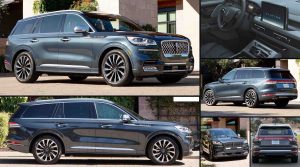
It also comes standard with a twin-turbocharged V6 – just like the Navigator does.
But unlike the Navigator, which comes with just the V6 – the Aviator is available with something in addition to the V6. A plug-in hybrid system is optional that gives you 630 ft.-lbs. of torque and gets you to 60 in just over 5 seconds . . . while giving you the legs of a Prius.
400-plus miles of range without a fill-up. And without having to charge up.
Prices start at $51,100 to start for the base trim with rear-drive – just shy of $25k less than the base price of the Navigator ($75,495).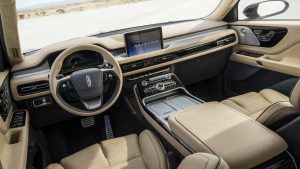
With the hybrid option and Lincoln’s Black Label concierge services – which include pick-up and delivery when maintenance work is needed, VIP access to exclusive venues and other perks – the sticker tops out at $77,691.
One of the few things the Aviator hasn’t got that the Navigator does is a transfer case and 4WD Low range gearing.
A lighter-duty all-wheel-drive system is available optionally – and standard equipment in the Grand Touring and Black Label trims.
What’s New
The Aviator name returns – as an all-new model based on the same RWD platform as the also all-new 2020 Ford Explorer.
Elegant rather than obstreperous.
Nearly Navigator spaciousness – without taking up as much space.
Real SUV towing capability.
What’s Not So Good
More powerful hybrid Grand Touring/Black Label Grand Touring trims weigh more than they can tow.
About two inches less ground clearance than Navigator – and no low-range gearing.
Paper thin (to save weight) hood and body panels – something not good about new vehicles generally.
Unlike the Navigator – which comes with the same twin-turbo V6 regardless of trim – the Aviator is available with either a twin-turbo 3.0 liter V6 that makes 400 horsepower and 415 ft.-lbs. of torque or the same V6 paired with a plug-in hybrid system that bumps the total output up to 494 horsepower and 630 ft.-lbs. of torque.
That’s by far the most torque available in anything shy of a Kenworth.
It also bumps the Aviator’s range up to more than 400 miles on a tank – two-thirds as far as you can take a Prius – and twice as fast. It’s also twice as far as most electric cars can go before they have to stop.
You can plug the Aviator hybrid in – but you don’t have to. This eliminates range anxiety and gives you flexibility. Plug in if you like, when you like – but skip it if you don’t feel like it. Electric vehicles force you to stop – and wait – if you run low on charge.
Have your torque – and eat it, too!
Grand Touring/Black Label Grand Touring models with the V6/hybrid drivetrain come standard with AWD and – oddly – a lower 5,600 lb. maximum towing rating, despite the Kenworth torque.
This is probably because of the additional 863 pounds of hybrid gear – the battery pack/electric motor – they’re carrying around. This bumps the curb weight of the thing up to 5,673 lbs. – which is a third heavier than the non-hybrid, rear-wheel-drive Aviator (4,774 lbs.).
But while the hybrid may not tow as much – it definitely hauls.
Zero to 60 in 5.1 seconds – and 17 city, 24 highway.
Both numbers are, for the record, better than the Navigator’s.
The Aviator feels like it could fly. You almost expect the Sync infotainment system to call out minimums – V1, V2 – rotate! Even without the optional adaptive suspension that scans the road ahead for uneven pavement and adjusts for it ahead of time – you’ll feel as though there’s air rather than asphalt under the wheels.
It’s that good.
And that relaxing.
In Lincoln’s words, a sanctuary.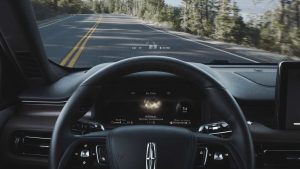
Non-fussy controls for all the luxuries – including the optional massaging seats, which you can activate via a simple, accessible button on the door panels (separate controls for the driver and front seat passenger) rather than having to scroll through multiple tap/swipe menus.
Likewise, the transmission is engaged via pleasantly retro and refreshingly tactile individual push-buttons. One for Park, another for Reverse and one more for Drive – just like Lincolns in the ’60s. A single rotary/push button controls the various drive modes, including Excite (basically, sport mode) Normal and Conserve.
No learning curve to fly this ride.
The hybrid version is electric car silent when in EV mode – there are actually two EV modes, Pure and Preserve – and can be driven this way for about 18 miles, depending on the state of the battery pack’s charge and how you drive. Or it can be muscle car ferocious – as your right foot wills. The 630 ft.lbs. of torque on tap negates 5,000-plus lbs. of Aviator in the manner of a UFO’s anti-gravity drive. That much leverage makes the Aviator feel light as a waffle – even though it weighs more than two tons.
This three-row, almost full-sized SUV is faster than my half-its-size Trans-Am, which has an engine more than twice the size – and which burns up at least a gallon of gas every 18 miles and does not have massaging seats.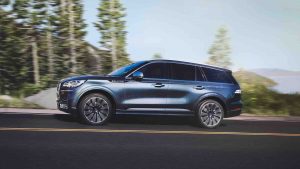
The Aviator’s rear-drive layout also gives it balance that nose-heavy/tail-light FWD-based crossovers can’t match . . . without loading their cargo area full of sandbags. Better balance than the Navigator, because the Aviator sits about two inches less ground clearance – and doesn’t have 4WD low range gearing.
Lincoln decided to not to offer a truck-type 4WD system with the Aviator; the optional all-wheel-drive system does have a Slippery and Deep mode that adjusts the shift characteristics of the ten-speed automatic, as well as the traction/stability control system (to allow a bit more slip – so that you don’t get stuck) but this is an on-road SUV.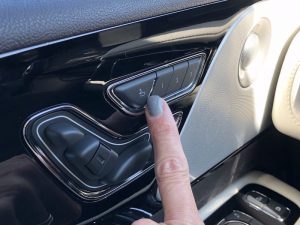
Being lower to the ground enhances stability and reduces wind/road noise as well as aerodynamic drag. And the AWD system – unlike most part-time 4WD systems – is designed to be used on-road, when it isn’t snowing or wet. In other words, it’s a handling advantage as well as a traction advantage.
This three-row, almost-full-size SUV corners better than my Trans-Am. I have a video of this but don’t dare publish it. Take my word for it, though. You can do things in this thing that – summoning Rutger Hauer voice from Blade Runner – you people wouldn’t believe.
There is also a parking advantage – vs. the Navigator (my Trans-Am wins this one).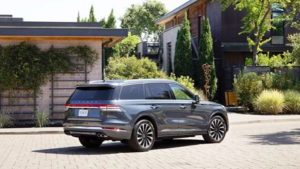
The Aviator is big – 199.3 inches long overall – but not as big as the Navigator, which is 210 inches long overall. That extra margin of wiggle room may seem small on paper but can make all the difference when you’re trying to make a tight spot work. It also means you will probably be able to walk behind the Aviator when it’s parked in your garage whereas if you have a Navigator, you may have to open the garage door to get behind it.
A tighter-than-Navigator turning circle helps with U turns, too.
Overall, it is much more pleasant to drive – and not just because of its proportions.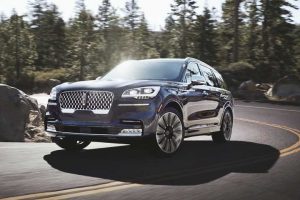
All the latest driver “assist” features are here – but they’re in the background and mostly mind their own business. The Aviator will automatically apply the brakes for you if you’re actually unconscious behind the wheel and about to hit something – but unlike so many other such systems, it won’t do so if it thinks you might hit something that’s 20 yards ahead of you.
The Lane Centering system doesn’t jerk the wheel in the direction you don’t want to go.
Even the loathsome ASS – the automated stop/start system which almost all new vehicles have as standard equipment – can be permanently turned off.
Scroll trough the settings to “driver assists” – and de-select the ASS. The engine will no longer automatically cut off every time the Aviator stops moving, which gets very annoying. 
In many other new cars, you have to turn the auto-stop system off every time you go for a drive . . . if you don’t want the engine to stop at every red light.
And then there are those massaging seats! They almost make you want to stop. Every electric car should have them – to make the wait less annoying. Of course, they use electricity – which is a problem when you run out of charge.
No heat, either – which is created by electricity.
If you haven’t got any, it’s going to get cold.
Enjoy the wait.
Like all the latest Lincolns, the Aviator has a cool, confident appearance. As opposed to the John Gotti appearance some others have. This is a welcome return to a past when luxury was synonymous with class rather than flash.
JFK’s 707 – vs. Trump’s 747.
It’s also lower – and sleeker – than the Navigator; the length to width proportions are eye-catching. It doesn’t look like a hulking SUV – but it also doesn’t look like a looks-like-everything-else crossover, either.
Lincoln says the Aviator is mid-sized and that’s technically true – but it’s very close to being full-sized where it matters.
Three rows – and as much room in the first two as in the full-sized Navigator. More front-seat legroom, actually (43 inches vs. 41.8 in its bigger brother). And an easier-to-access third row, because of the Aviator’s lower step-in height.
The Navigator does have more cargo room – with its third row folded (103.3 cubic feet vs. 77.7) but with the third row in use, it’s almost a dead heat: 18.3 cubic feet vs. 19.3 cubic feet.
Available Aviator amenities include four-zone climate control, an Elements Package with heated windshield wipers and an exceptional 28 speaker Revel ultra-premium audio system. You can also get a min-console for the second row, along with power-folding captain’s chairs.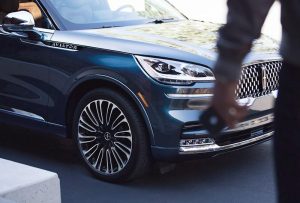
Standard amenities include three-zone climate control, a very good 10-speaker audio rig and a couple of uniquely Lincoln features, including a door-mounted keypad entry system, which Lincoln has been offering since the ’80s and which makes it almost impossible to lock yourself out of your Lincoln. Just tap you code – and the doors unlock.
And from the inside, you unlock the doors by lightly touching a button. No handles to . .. manhandle.
Or, use your smartphone to get in – and drive – without touching anything.
The one thing that’s very not-retro about the Aviator – and everything else that’s new – is the wafer-thin metal used for the hood and body panels. And all the plastic – front and rear.
It’s an irony of our era that new vehicles are very safe – and very fragile. It is easy to incur massive damage – not to the people inside but to the metal (and plastic) outside. A 1963 Continental that tapped the car ahead might have needed to have its bumper pulled out and polished. Do the same in a new vehicle – not just the Aviator – and you might need a new front end.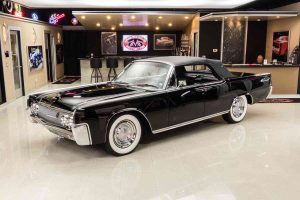
The crashworthiness is built into the structure – the parts you can’t see. The parts you can see – fenders, hood, those plastic front and rear clips – are designed to offer no structural resistance at all. They are purely cosmetic – and made to be as light as possible, to make up for the weight of the structural parts necessary to make the vehicle crashworthy while also keeping it fuel efficient – to comply with the conflicting requirements of federal mandatory MPG minimums (also the reason for ASS, which no one buying vehicles asked for).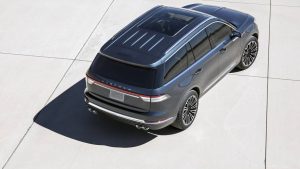
The government’s MPG mandates “save you money” – on fuel. But cost you a fortune when you have a fender-bender. And even if you don’t – because you might. Which is the calculation insurance companies make when they issue policies. What it will cost to fix – or replace – is reflected in what you pay, even if you never have to get it fixed.
The Bottom Line
The only mistake Lincoln may have made here is making the Aviator more appealing in many ways – and much less expensive – than its top-of-the-line SUV.
. . .
Got a question about cars, Libertarian politics – or anything else? Click on the “ask Eric” link and send ’em in!
If you like what you’ve found here please consider supporting EPautos.
We depend on you to keep the wheels turning!
Our donate button is here.
If you prefer not to use PayPal, our mailing address is:
EPautos
721 Hummingbird Lane SE
Copper Hill, VA 24079
PS: Get an EPautos magnet (pictured below) in return for a $20 or more one-time donation or a $10 or more monthly recurring donation. (Please be sure to tell us you want a sticker – and also, provide an address, so we know where to mail the thing!)
My latest eBook is also available for your favorite price – free! Click here. If that fails, email me at [email protected] and I will send you a copy directly!





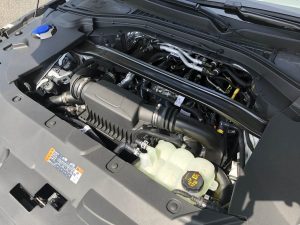

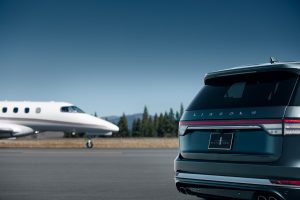
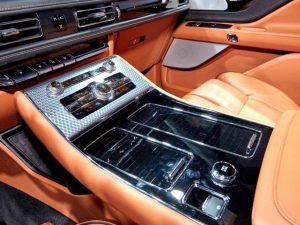
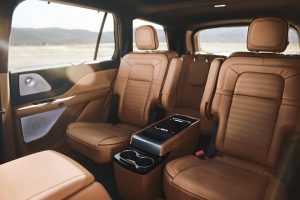
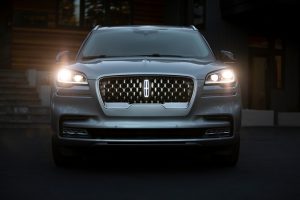







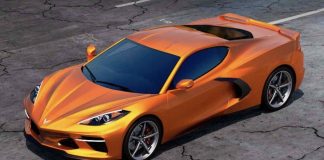
These new Lincoln vehicles just seem really nice. A throwback to the days of American luxury cars. Hopefully they will be reliable. Are the body panels aluminum on these now?
I was thinking why do I like the looks of certain cars over others. To me, the location of the front tires makes a big difference to how a car looks, to me. I really dislike to look of FWD cars because the front tires are located so far back. Then you look at a RWD car and the front tires are usually located much farther forward. Just me. Looks way better.
Ford keeps on delivering. GM sold their soul to Obummer and it is forever stained.
I’m not a fan to the big clunky console that hems you into the little drivers compartment. How is one supposed to man spread on longer drives? I resent having my knees jammed together by this stupid idea that a driver needs to be shoehorned into a little space just to be safe. That’s so feminist nanny state.
Ditto that, Auric!
Post-bailout GM remains government motors – even if the “loan” was paid back. The company became – and remains – an adjunct of government. It relies on mandates for business – and considers it more important to be “diverse” than to design can and manufacture cars people are willing to pay for with their own money…
This is easily the best looking and most functional car Lincoln has built since the middle 1960’s.
Sure, but can one see outside of it to perform normal driving procedures without an annoying video screen and the paraphernalia? I’d rather have the FIAT 124, but that comes with all of the crap too.
I assume that it costs twice what I paid for a pretty good house that my wife and myself bought in 1984. Actually she had no dough, but no debt, so it was akin to taking on an indentured servant, and I payed for the wedding crapola. The servant part has yet to be fulfilled..
Now that the fabulous stock market is in reverse peristalsis I will wait to see how they price these beasts. In late 08 I bought a very well equipped (for my taste) Chebby 1500 4WD for 23k. The diesel version was 30k.
My wife doesn’t like the high floor step up but I tell her to refrain from complaining ab she does comply I do not get why womyns want to be so high off of the road surface but that is likely a chromosomal argument. It might be practical too as the road surfaces are so much poorer than in the late 60s when low and light cars were my taste. I never had any intent and always avoided driving into a corn field.
I am becoming wordy on my recollections so I will sign off.
Eric
The Digital God is angry with you. I am getting a “This site is not secure” from Firefox. It’s not stopping me from viewing,,, just started. Maybe it is related to that 503 Service Unavailable a few days back.
Hi Ken,
A Clover hacked us… we are working on it…
When Ford announced the Explorer was going RWD, my first thought was “I hope there’s a Lincoln version” vs all the other FWD crap out there. Of course the Grand Cherokee is the standard, but this is going to put pressure on them for sure. GC can still get V8 and low range and is much more capable off road, but most don’t care about that stuff.
Lincoln knocked it out of the park with this car. This is one of favorite new verhicles out there. I’m sure Lincoln will do well with it. Congrats.
I just showed it to my wife last night in a parking lot and said she has choices next time (now GC V8)
My next wish is Lincoln makes a new Continental RWD. BUT, makes it avail. in RWD-only, unlike the Caddy CT6 AWD-only.
You should never show a new car to a wife. They have no notion of what is outside of the driving compartment or the maintenance costs. A week after I met my wife of now I offered to fix the brakes on her clapped out Toyota Corona. I instructed her on what to do but she pressed the brake pedal at the wrong time and shot a load into my eyes when under the car. I was blinded for quite a while so she offered to cook me dinner to compensate. She liked cats and my bird dog so we got married.
So they understand cars exactly as much as they need to, no?
> simple, accessible button on the door panels rather than having to scroll through multiple tap/swipe menus.
Or having to wave your hands in the air (like you just don’t care) that BMW has you do. I do not understand how anyone thought that was a good idea. Italian owners are probably wondering why their radio station keeps changing while they drive…
I’ve sat in all three sizes of the new Lincoln SUVs (Navigator, Aviator, & Corsair) and the Aviator is probably the “right sized” one for me. It would fit in the garage (once I move a shelving unit), and still has legroom for rear passengers.
Amen, Chip!
I really like this one myself – and you guys know what a technophobe . am!
I’m gonna hold out for the Cadillac Fornicator or the Dodge Terminator. Until then I’l just keep driving my 1974 Chevy Hesitator, lol!
Graves, you’re hilarious! When the hell are you coming over?
ASS is becoming so common now. Sitting in Houston traffic or at lights, I hear an orchestra of ignition noises in stop and go traffic. Then they go silent, then they start up again. How could anyone think the constant wear on the starter and alternator was worth the pissant gas savings?
Hi Brazos,
No one does! ASS is a forced standard feature. It is forced on us by the car companies, who are in turn forced to “achieve compliance” with MPG and “emissions” (C02) mandates. It is easily among the most stupid – and annoying – features to be forced upon us since the skip-shift transmission of the ’90s…
Don’t forget lethal, as some of the cars don’t tell you whether you cut it off or not, and has asphyxiated several owners on account of this nifty little “con-venience”!
If government was concerned about fuel economy it would time the traffic lights properly. Seat of pants estimation is that it would save more fuel than every mandate to do so of the last decade.
That is a very…. Very good looking car.
The lack of transfer case, 4WD Low, and offload-worthy ground clearance would not bother me. As you said, the lower center of gravity results in surprisingly good handling. I’d use it more as a stylish station wagon than a rock hopper, or mud runner.
Will best in class styling be enough to lead to a Lincoln market resurgence? I don’t know. But it sure can’t hurt.
Well don’t worry, they have nothing to fear from anything GM is putting out.
Hi Mike!
I love what Lincoln is doing – and wish them godspeed. Their vehicles are the antidote to everything awful that’s going on – especially over at Cadillac.
Cadillac doesn’t “move you?” That is about one the dumbest things coming out of GM’s marketing department since Like A Rock
Hi Swamp,
Cadillac lost its way when it decided to stop being Cadillac. It decided to try to be BMW… and Mercedes. But the whole point of buying a Caddy was to buy something different. Cadillac cars were bigger than any other cars; they were the apotheosis of luxury (not luxury-sport).
It’s so obvious… but the people running the joint are so blind they can’t see it…
It’s a well-known fact that luxury customers value authenticity. I’m not sure how Cadillac executives missed that, especially when their most desirable vehicle has been the Escalade.